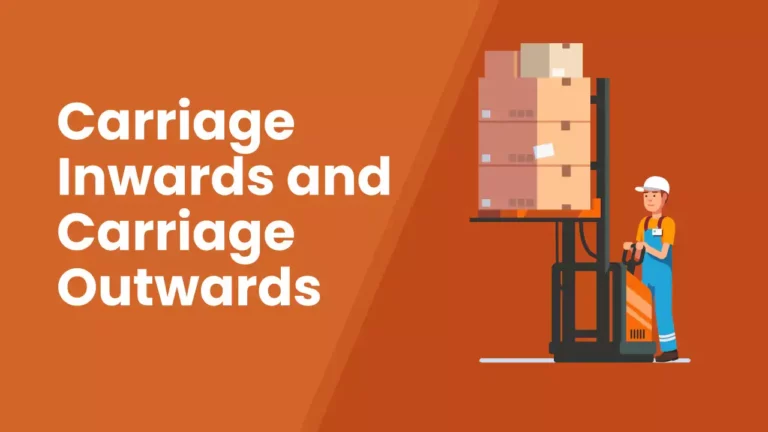Carriage Inwards and Carriage Outwards
What is Carriage Inwards?
Carriage Inwards, also known as Freight Inwards or Transportation Inwards, refers to the cost incurred by a business when purchasing goods or materials from a supplier. This cost covers the expenses associated with transporting the goods from the supplier’s location to the buyer’s place of business. Essentially, it includes all the costs involved in getting the goods to the buyer’s doorstep and becomes part of the overall cost of the purchased goods.
For example, if a company based in Bengaluru purchases raw materials from a supplier located in Delhi, the Carriage Inwards would include the expenses of transporting those materials from Delhi to Bengaluru. These expenses can include freight charges, loading and unloading fees, insurance during transit, and any other costs directly related to getting the goods to the buyer’s premises.

Importance of Carriage Inwards
- Inclusion in Cost of Goods Sold (COGS): Carriage Inwards is added to the cost of the purchased goods. This means that it forms a part of the Cost of Goods Sold (COGS) in the income statement. Including it in COGS provides a more accurate representation of the total cost incurred in obtaining inventory.
- Impact on Profit Margins: A business can determine its true profitability by correctly accounting for Carriage Inwards. Neglecting to include these costs may lead to distorted profit margins and financial statements.
- Tax Deductions: In some jurisdictions, Carriage Inwards expenses may be tax-deductible. Accurate record-keeping of these costs can help a business reduce its taxable income.
How to Record Carriage Inwards
To record Carriage Inwards in accounting, follow these steps:
- Identify the Expenses: Gather all relevant invoices, bills, and receipts related to the transportation of goods.
- Create an Account: In your accounting software or ledger, create an account specifically for Carriage Inwards expenses.
- Record the Expenses: Enter the details of the expenses in this account, including the date, supplier, description of the goods, and the amount paid.
- Include in COGS: When calculating the Cost of Goods Sold for the period, include the total Carriage Inwards expenses as part of the overall cost of inventory.
- Reconciliation: Regularly reconcile your Carriage Inwards account to ensure accuracy and completeness.
What is Carriage Outwards?
Carriage Outwards, also known as Freight Outwards or Transportation Outwards, pertains to the transportation costs incurred by a business when delivering goods to customers or other destinations. It is essentially the opposite of Carriage Inwards, as it deals with the expenses of shipping goods away from the business premises.
When a business sells its products, it often needs to transport those goods to the buyer’s location. Carriage Outwards encompasses expenses such as shipping fees, packaging costs, insurance during transit, and any other expenditures associated with delivering the goods to the customer. These costs are treated as selling and distribution expenses in a company’s financial records.
Importance of Carriage Outwards
- Cost of Sales: Just as Carriage Inwards is added to the Cost of Goods Sold, Carriage Outwards is included in the Cost of Sales (COS) or Cost of Revenue. This reflects the true expenses associated with generating revenue.
- Profitability Analysis: By accounting for Carriage Outwards, a business can analyze the costs associated with its sales operations and assess their impact on profit margins.
- Pricing Strategies: Understanding Carriage Outwards costs can help in setting appropriate pricing strategies, ensuring that the selling price covers both production and delivery expenses.
How to Record Carriage Outwards
Recording Carriage Outwards in accounting involves these steps:
- Gather Documentation: Collect all invoices, receipts, and records related to the transportation of goods to customers.
- Create an Account: Set up an account in your accounting system dedicated to Carriage Outwards expenses.
- Enter Expenses: Record the Carriage Outwards expenses in this account, including details like the date of shipment, destination, description of goods, and the amount spent.
- Include in COS: When calculating the Cost of Sales or Cost of Revenue for the period, include the total Carriage Outwards expenses to represent the cost associated with generating revenue accurately.
- Regular Review: Periodically review and reconcile your Carriage Outwards account to ensure accuracy and completeness.
Differences Between Carriage Inwards and Carriage Outwards:
Now that we have a clear understanding of both terms, let’s highlight the key differences between Carriage Inwards and Carriage Outwards:
- Direction: Carriage Inwards pertains to transportation costs incurred when acquiring goods from suppliers, while Carriage Outwards relates to expenses associated with delivering goods to customers.
- Recording: Carriage Inwards is added to the Cost of Goods Sold (COGS), which is an expense category on the income statement. In contrast, Carriage Outwards is included in the Cost of Sales (COS) or Cost of Revenue.
- Purpose: Carriage Inwards is essential for determining the accurate cost of inventory and calculating the cost of goods sold. Carriage Outwards helps in assessing the costs associated with sales and distribution.
- Impact: Carriage Inwards affects a company’s profitability by influencing profit margins. Carriage Outwards affects the overall cost structure of generating revenue.
Understanding the distinction between Carriage Inwards and Carriage Outwards is crucial for maintaining accurate financial records and making informed decisions. Both these terms play a pivotal role in determining the true cost of goods and the expenses associated with delivering products to customers. By recording and analysing these costs diligently, businesses can enhance their financial transparency and profitability.
